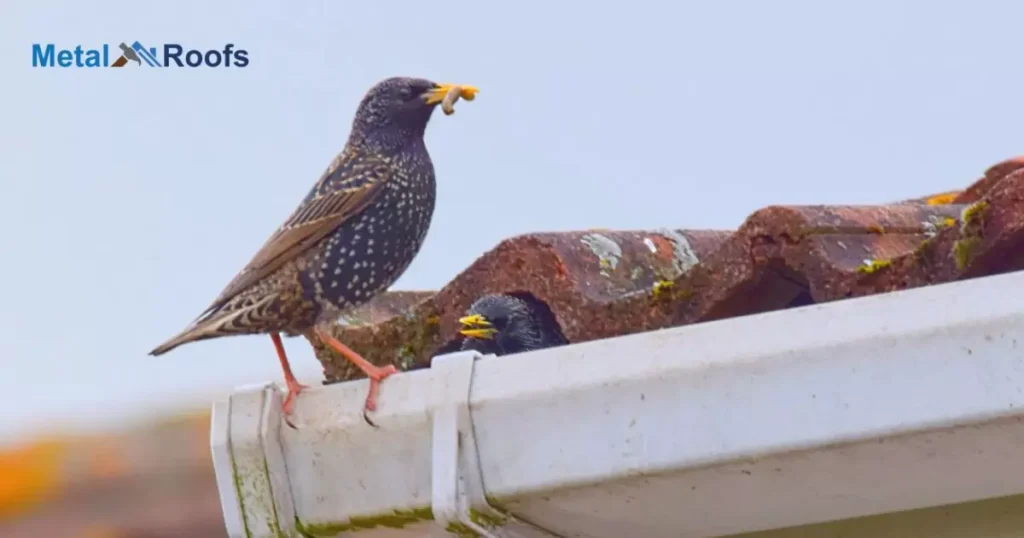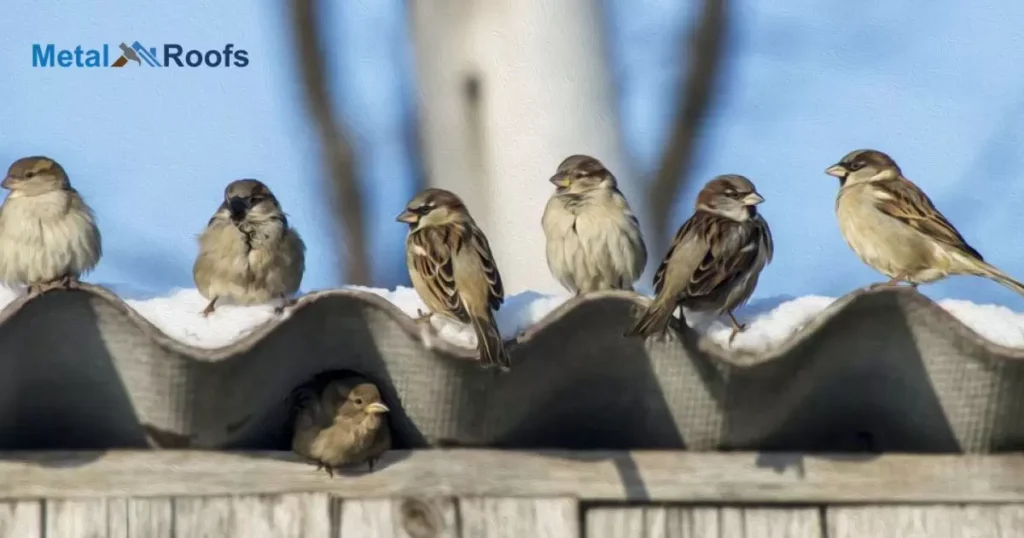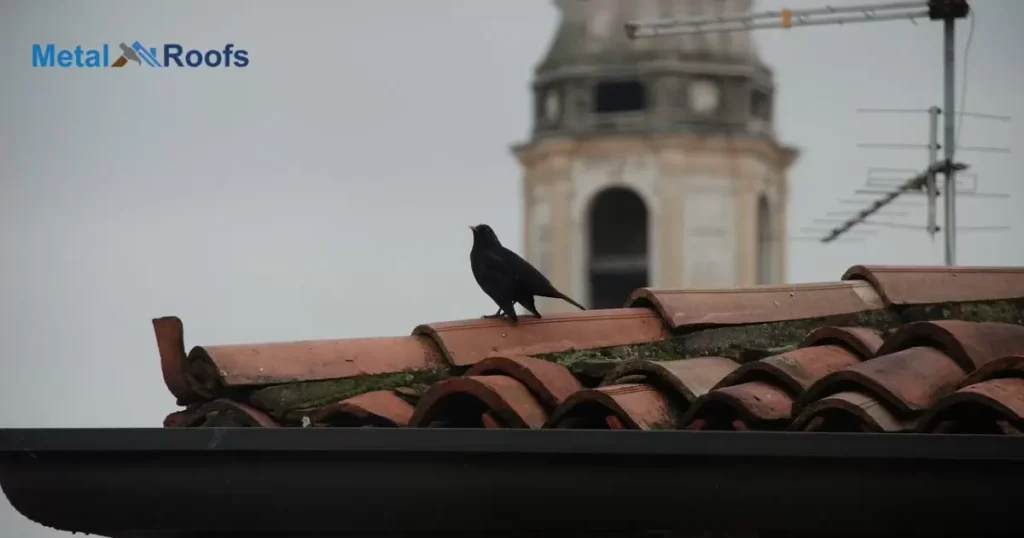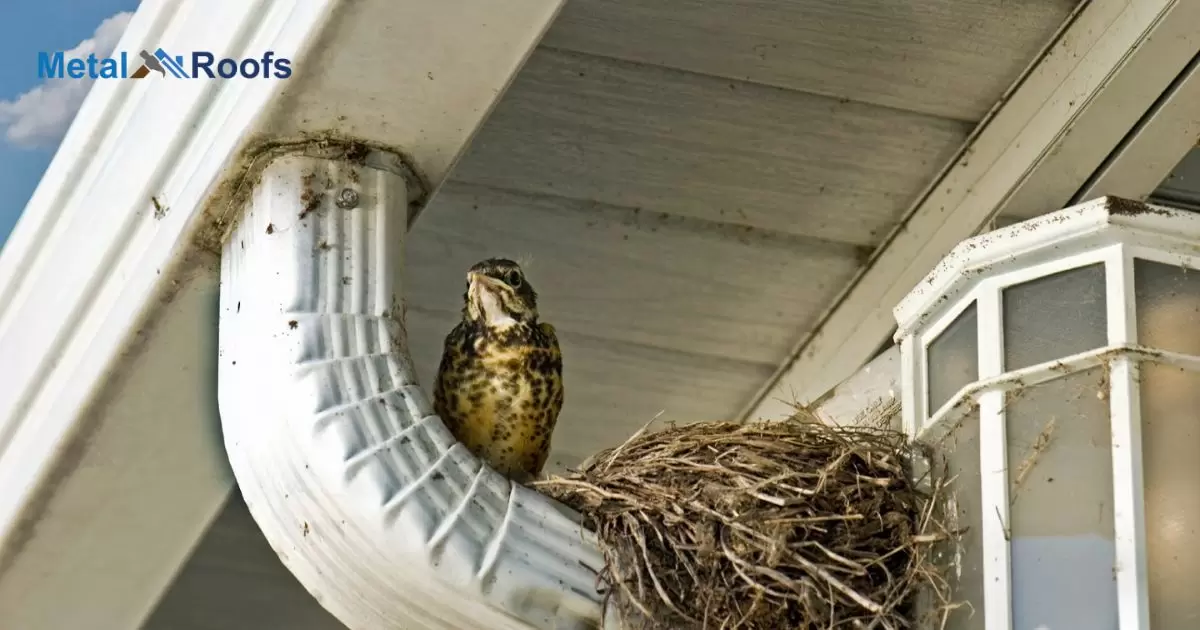Birds like pigeons and sparrows often build nests on rooftops to safely raise their young, constructing them from found items like twigs, feathers, and trash; the ledges and overhangs offer shelter and height from predators as the busy parents fly in and out feeding hungry chicks.
Birds nesting on roofs can be a nuisance with the chirps, feathers, and droppings. How to get rids of birds nesting on the roof? There are humane ways to discourage them like wire mesh, slope modifiers, coil spikes that don’t harm the birds but deter building their messy nests up there.
Nest on rooftops for safety from predators. But their nests can cause issues like clogs in drains from materials carried in. The droppings and feathers can also damage infrastructure. So while the birds have their reasons, property owners have a responsibility to humanely prevent these problems.
Key Takeaways
- Blocking access points and maintaining the roof can deter birds.
- Use visual, noise, or physical barriers to discourage nesting.
- Trim trees and shrubs, and clean gutters to prevent nesting areas.
- Seek help if bird infestation persists or if legal regulations need consideration.
Birds In The Roof
To tackle birds nesting on your roof, start by sealing any openings. Block vents and gaps where they enter. Then, use visual tricks to deter them. Reflective items and fake predators like plastic owls can help.
Consider noise deterrents like wind chimes. Mechanical noise devices, such as installing Butyl Tape On Metal Roof, can also work. Keep trees trimmed to limit perching spots. Lastly, if the problem persists, seek professional help. Pest control experts can offer tailored solutions.
Why Stop Birds Nesting Under Roof Tiles?

Birds nesting under roof tiles can cause damage. Nests block vents, leading to poor ventilation. Droppings can corrode roofing materials. Blocked gutters cause water damage. Nests can attract insects and pests. Removing nests can be difficult. Deterrence is crucial to prevent nesting. Use humane methods to discourage birds.
Bird Droppings
Bird droppings can damage roofs. They contain acidic substances that corrode surfaces. Regular cleaning helps prevent damage. Bird droppings are unsightly. They can also spread diseases. Proper cleaning is essential. Use protective gear when cleaning. Dispose of droppings safely. Regular maintenance keeps roofs clean.
Ways To Prevent Birds Nesting In Your Roof
Preventing birds from nesting on your roof requires a combination of deterrents and maintenance strategies. Here are some effective ways to discourage birds from nesting in your roof:
Install Bird Spikes or Deterrents: Bird spikes are devices made of plastic or metal that can be attached to ledges, rooflines, or other areas where birds commonly roost. These spikes make it uncomfortable for birds to land, preventing them from nesting.
Use Bird Netting: Bird netting is a physical barrier that can be installed over areas where birds are nesting or likely to nest. It prevents birds from accessing these areas while still allowing airflow.
Block Access Points: Inspect your roof for any gaps, holes, or openings that birds might use to enter and nest. Seal these openings with mesh wire, foam sealant, or other appropriate materials to prevent access.
Trim Overhanging Branches: Overhanging branches near your roof can provide easy access for birds to reach and nest. Trim back any branches that are within close proximity to your roofline.
Install Chimney Caps or Screens: If you have chimneys, vents, or other openings on your roof, install chimney caps or screens to prevent birds from entering and nesting inside.
Keep Gutters Clean: Birds may use debris in clogged gutters as nesting material. Regularly clean out your gutters to remove leaves, twigs, and other materials that birds could use for nesting.
Remove Food Sources: Birds are attracted to areas where they can find food. Keep bird feeders away from your roof and clean up any spilled birdseed or food scraps in your yard.
Use Visual Deterrents: Install reflective objects such as shiny tape, CDs, or scare balloons near your roofline to create visual disturbances that deter birds.
Ultrasonic Devices: Consider using ultrasonic devices designed to emit sound frequencies that are unpleasant for birds, effectively discouraging them from nesting in the area.
Scare Tactics: Use scare tactics such as predator decoys (like fake owls or hawks), motion-activated lights, or sprinkler systems to deter birds from nesting in your roof.
Professional Assistance: If you’re dealing with a persistent bird nesting problem, consider seeking help from pest control professionals or wildlife experts who can offer specialized solutions tailored to your situation.
By implementing these preventive measures, you can effectively discourage birds from nesting in your roof and minimize any associated damage or nuisance.
What Attracts Birds to Your Roof?

Birds are attracted to your roof because it offers shelter and warmth. They seek out spots where they can build nests and raise their young. Openings or gaps in your roof provide easy access for birds to enter and nest.
Food supply
Birds are also drawn to your roof by the presence of food. They may find insects, seeds, or other food sources nearby. These food supplies attract birds looking for nourishment, making your roof a convenient spot to perch and feed.
Nesting sites
Nesting sites are a key attraction for birds to your roof. They look for places that offer protection from predators and the elements. Openings or gaps in your roof serve as ideal locations for birds to build their nests.
Lack of predators
Nesting sites are a key attraction for birds to your roof. They look for places that offer protection from predators and the elements. Openings or gaps in your roof serve as ideal locations for birds to build their nests.
Useful Tips To Deter Birds Nesting On Roofs
Here are some specific and useful tips to deter birds from nesting on roofs:
Install Bird Spikes: Attach bird spikes to potential nesting sites like ledges and eaves to discourage birds from landing and nesting.
Use Bird Netting: Cover vulnerable areas of your roof with bird netting to physically block birds from accessing nesting spots.
Trim Overhanging Branches: Cut back branches and vegetation near your roof to limit access points and make it harder for birds to nest.
Seal Entry Points: Inspect your roof for gaps and openings, sealing them with mesh wire or foam sealant to prevent bird entry.
Employ Visual Deterrents: Hang reflective objects or decoys of natural predators near nesting areas to create visual disturbances that deter nesting.
By combining several of these methods and tailoring them to your specific situation, you can effectively deter birds from nesting on your roof.
What Sort of Damage Can Birds Do to a Roof?

| Damage | Description |
| Nesting in Gutters | Blockages leading to water pooling and leakage. |
| Corrosion from Droppings | Acidic droppings corrode roofing materials. |
| Structural Weakness | Weakening of roof structure due to continuous nesting. |
| Damage to Roofing | Pecking or pulling apart roofing materials. |
| Water Damage | Leakage into the building from blocked gutters. |
| Increased Pest Infestation | Attraction of pests due to accumulated materials. |
Birds nesting on a roof can cause various types of damage. They often build nests in gutters and drains, leading to blockages that can cause water to pool and eventually leak into the roof. Bird droppings contain acids that can corrode roofing materials over time, leading to deterioration and weakening of the roof structure.
These damages can result in costly repairs and compromises the integrity of the roof, potentially leading to further issues like water damage to the interior of the building. Regular maintenance and bird deterrent measures can help prevent such damage and preserve the lifespan of the roof.
Frequently Asked Questions
What stops birds from nesting?
Birds are deterred from nesting by blocking access to potential nesting sites and using visual or noise deterrents.
What is the solution for birds on the roof?
The solution for birds on the roof is to implement deterrents like visual and noise deterrents, and to block access points to prevent nesting.
What smell keeps birds away?
Citrus and vinegar scents are effective at deterring birds from nesting.
Conclusion
Birds nest on roofs seeking safe shelter to raise young, but their debris can cause property damage. Discouraging them humanely maintains building integrity. Start with low-impact deterrents like slope changes and coil spikes. If still ineffective, mesh netting physically blocks access.
A multifaceted humane approach is best before considering stronger exclusion methods. Prioritize nest removal in drainage areas first. Monitor over several seasons for persistent problem spots. Adapt solutions based on specific locations and species. With some clever effort roofs can stay clear without harming birds.











